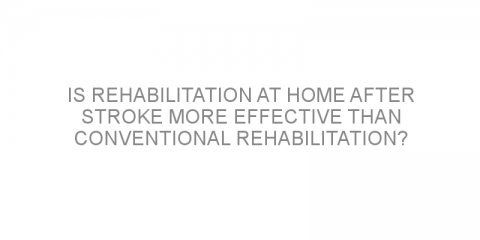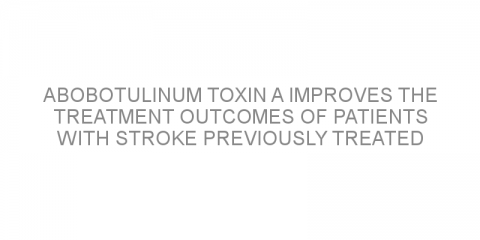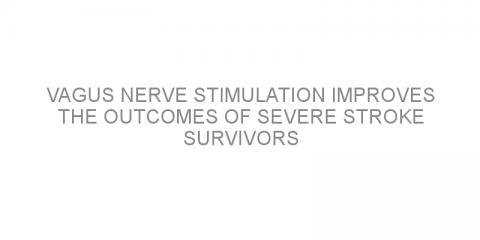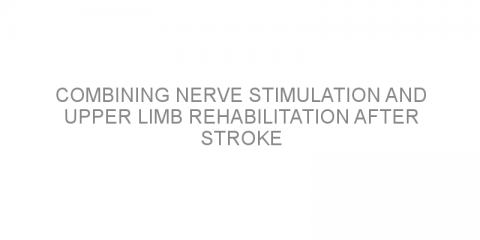In a nutshell This study compared the effect of a conventional rehabilitation (CR) program to a home-based motor training rehabilitation (TR) program for patients with hemiplegia after stroke. The study showed that TR positively impacts movement function in the upper and lower extremities as well as skills...
Read MoreNature of disability-Motor disability Posts on Medivizor
Abobotulinum toxin A improves the treatment outcomes of patients with stroke previously treated with other botulinum toxin drugs
In a nutshell This study investigated the effectiveness and safety of abobotulinumtoxinA (ABTA) in the treatment of patients with stroke who previously received other botulinum toxin products. Researchers suggested that ABTA was associated with improved outcomes for these patients. Some background Around 795,000 people in the US have a stroke, every...
Read MoreVagus nerve stimulation improves the outcomes of severe stroke survivors
In a nutshell This study investigated the effectiveness of vagus nerve stimulation (VNS) in treating stroke survivors. Researchers suggested that VNS is associated with a positive response in patients with more severe disease. Some background Each year, around 795,000 Americans suffer a stroke. It happens when the blood flow to the brain stops due to...
Read MoreExtracorporeal shock wave therapy improves outcomes of stroke survivors
In a nutshell This study investigated the long-term effects of extracorporeal shock wave therapy (ESWT) in the treatment of stroke survivors. Researchers suggested that ESWT is associated with improved outcomes in these patients. Some background A stroke happens when blood flow to the brain is cut-off. Brain cells stop receiving oxygen and begin to...
Read MoreBrain stimulation improves posture and balance in stroke survivors
In a nutshell This study reviewed the effectiveness of brain stimulation (BS) in treating symptoms after stroke. Researchers suggested that BS is associated with improved recovery in these patients. Some background A stroke is caused by a blood cut-off to the brain. This is followed by the death of brain cells that stopped receiving oxygen. The...
Read MoreEvaluating the Italian adaptative physical activity exercise program for stroke survivors
In a nutshell This study investigated whether the Italian adaptative physical activity program (APA) for stroke survivors is feasible in the United States. Researchers suggested that this program improves the outcomes of survivors and is feasible in the United states. Some background Stroke is a leading cause of long-term disability in the US. A...
Read MoreCan nerve stimulation improve muscle stiffness in patients with stroke?
In a nutshell This study investigated the effect of transcutaneous (through the skin) electrical nerve stimulation (TENS) in muscle stiffness after a stroke. Researchers suggested that TENS reduces leg stiffness in these patients. Some background Muscle stiffness after stroke affects the quality of life of patients and their caregivers. Up to 43% of...
Read MoreLooking for patients who had a stroke to test a new device for arm rehabilitation
In a nutshell This phase 3 trial is examining the effectiveness and safety of a virtual reality therapy in the treatment of patients with impaired arm movements after a stroke. The main outcome to be measured is an improvement of arm function and in the quality of life of these patients. This study is taking place in California, US. The details...
Read MoreFocus and movement in stroke rehabilitation
In a nutshell This study aimed to see if internal or external focus affects dual performance in unilateral (one side of the body was affected) stroke patients. The study found no significant difference between which type of focus was used. Some background Performing two tasks at once – such as walking and texting – can be difficult for...
Read MoreCombining nerve stimulation and upper limb rehabilitation after stroke
In a nutshell This study examined the safety and potential effectiveness of using vagus nerve stimulation (VNS) in combination with rehabilitation to improve upper limb function following stroke. It concluded that VNS is safe and has the potential to improve upper limb function when combined with rehabilitation movements. Some background...
Read MoreVisual cues are safe and feasible to include in post stroke walking rehabilitation
In a nutshell This trial assessed whether it was safe to include visual cue training (VCT) in rehabilitation therapy for patients following stroke. The study concluded that VCT was feasible to use in post stroke rehabilitation and may potentially improve walking speed, balance and walking symmetry. Some background Following stroke, patients often...
Read MoreCan fitness training improve outcomes following a stroke?
In a nutshell This review explored whether physical fitness training plays a role in reducing disability, dependence and mortality following strokes. Some background Physical fitness refers to how easily a person can perform physical activities. When physical fitness is low, even daily activities such as climbing stairs or walking can become...
Read More













